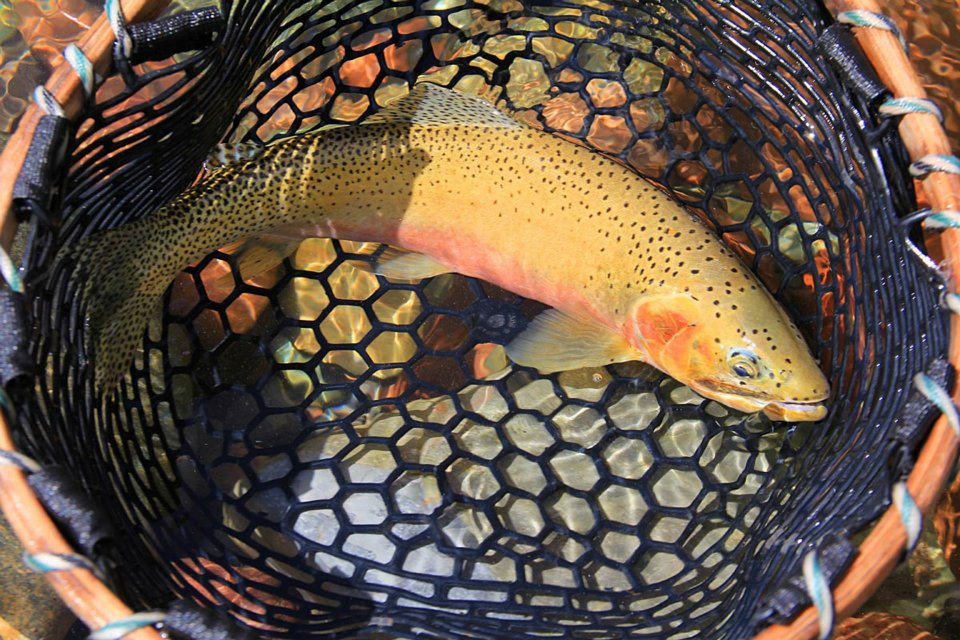The United States is a treasure trove of diverse fish species, and among them, the cutthroat trout holds a special place as an iconic symbol of pristine freshwater ecosystems. With its distinctive red-orange slashes beneath the lower jaw, the cutthroat trout family comprises an impressive collection of subspecies, each unique in appearance, habitat, and cultural significance. In this blog post, we embark on an extraordinary journey to discover 9 subspecies of cutthroat trout found throughout the United States.

Coastal Cutthroat Trout (Oncorhynchus clarkii clarkii)
The coastal cutthroat trout is a resilient fish species that thrives along the Pacific Coast, spanning from Alaska to northern California. Renowned for its remarkable adaptability, this anadromous subspecies showcases an impressive ability to navigate both freshwater and saltwater environments. Sporting an olive-green body adorned with dark speckles, the coastal cutthroat trout captivates observers with its stunning appearance. One of its most striking features is the vibrant red-orange slashes adorning its throat, enhancing its allure.
The life cycle of the coastal cutthroat trout involves awe-inspiring migrations as it seeks optimal conditions for survival. These trout begin their journey in freshwater habitats, typically found in streams, rivers, and lakes. Here, they undergo crucial stages of their development before embarking on their arduous transition to saltwater environments. The trout undertake extraordinary migrations, traversing vast distances and braving various challenges to reach the ocean. Once in the saltwater realm, they adapt to the marine environment, utilizing the abundant resources available to grow and mature. When the time comes to spawn, these resilient fish return to their natal freshwater habitats, completing a remarkable cycle of migration and perpetuating their species. The coastal cutthroat trout’s ability to seamlessly navigate between freshwater and saltwater habitats exemplifies its tenacity and serves as a testament to its incredible survival instincts.

Lahontan Cutthroat Trout (Oncorhynchus clarkii henshawi)
The Lahontan cutthroat is a remarkable fish species that is endemic to the Great Basin region of Nevada and California. It holds the distinction of being the largest subspecies of cutthroat trout, known for its adaptability to the harsh desert environments of the area. The Lahontan cutthroat trout’s historical habitat was ancient Lake Lahontan, which was once a vast inland sea covering a significant portion of the region. Over time, as the lake dried up, the trout found a way to survive in alkaline lakes and streams.
With its striking physical characteristics, the Lahontan cutthroat trout has become an emblem of conservation efforts in the region. These trout possess a silvery body and are adorned with vibrant red-orange slashes on their throats. Their captivating appearance has made them a popular subject for artists and photographers, further amplifying their significance. The conservation of the Lahontan cutthroat trout involves preserving its natural habitat and managing the fish populations to ensure their long-term survival. Efforts include the restoration of streams and waterways, as well as implementing fishing regulations to protect these iconic fish and promote sustainable practices. One notable location associated with the preservation of the Lahontan cutthroat trout is Pyramid Lake, a renowned fishing destination situated in Nevada. Pyramid Lake plays a crucial role in the conservation of this species, providing a thriving ecosystem and a sanctuary for the Lahontan cutthroat trout.

Yellowstone Cutthroat Trout (Oncorhynchus clarkii bouvieri)
The Yellowstone cutthroat trout, named after the majestic national park it inhabits, finds its sanctuary in the vast mountainous watersheds of the Yellowstone River and its tributaries. These trout are celebrated for their captivating beauty, characterized by a golden body adorned with dark spots and a unique reddish flush on their lower fins. Their vibrant colors make them a sight to behold, attracting anglers and nature enthusiasts alike to the pristine waters they call home.
Conservation initiatives play a vital role in safeguarding the Yellowstone cutthroat trout from various threats that jeopardize their existence. One of the significant challenges faced by this subspecies is the introduction of invasive species, which compete for resources and disrupt the delicate balance of the ecosystem. Additionally, habitat degradation poses a significant risk, as factors like pollution, erosion, and water diversion can negatively impact the trout’s spawning and feeding grounds. To protect the Yellowstone cutthroat trout, conservation efforts focus on preventing the spread of invasive species, restoring and preserving crucial habitats, and implementing sustainable fishing practices. These initiatives aim to ensure the long-term viability of this iconic species, allowing future generations to witness the awe-inspiring beauty of the Yellowstone cutthroat trout in its natural habitat.
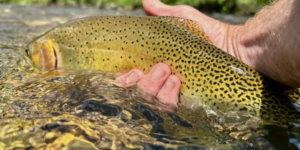
Westslope Cutthroat Trout (Oncorhynchus clarkii lewisi)
In the Pacific Northwest, the Westslope cutthroat trout flourishes, showcasing a remarkable array of colors. Its dorsal region boasts a deep green or olive hue that gracefully transitions into a captivating golden or yellow belly. Embellished with scattered black spots, this subspecies epitomizes the breathtaking beauty that characterizes the pristine wilderness of the region.
Conservation efforts play a crucial role in safeguarding the Westslope cutthroat trout and preserving its vital habitat. One of the primary concerns is the potential hybridization with non-native trout species, which can lead to genetic dilution and the loss of unique characteristics of the Westslope cutthroat trout. To mitigate this threat, conservation initiatives focus on implementing measures to prevent the introduction of non-native species into the habitats of the Westslope cutthroat trout. Furthermore, efforts are directed towards preserving the ecological integrity of the streams and rivers that serve as their homes. This involves maintaining water quality, protecting spawning grounds, and ensuring sufficient habitat for their population to thrive.
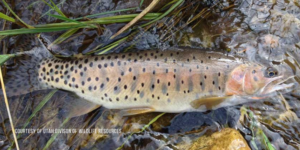
Bonneville Cutthroat Trout (Oncorhynchus clarkii utah)
The Bonneville cutthroat trout, native to the Bonneville Basin of Utah, is a captivating fish known for its distinctive features. This subspecies is recognized for its deep body structure, displaying a striking golden coloration that adds to its allure. The Bonneville cutthroat trout’s beauty is further enhanced by small, scattered spots that adorn its body, creating a mesmerizing sight.
Unfortunately, the Bonneville cutthroat trout has experienced significant population declines over the years due to various factors. Habitat loss, primarily caused by human activities such as water diversions and land development, has severely impacted the trout’s native habitats. Additionally, overfishing and the introduction of non-native fish species have posed significant challenges for the survival of the Bonneville cutthroat trout. However, conservationists and fisheries management agencies have taken up the responsibility of restoring this subspecies to its former abundance. Dedicated restoration efforts are now underway, focusing on habitat preservation, population monitoring, and the implementation of fishing regulations to protect the Bonneville cutthroat trout and promote its recovery. These efforts aim to safeguard the unique genetic lineage of the Bonneville cutthroat trout and ensure the long-term survival of this remarkable fish species in the Bonneville Basin.

Colorado River Cutthroat Trout (Oncorhynchus clarkii pleuriticus)
In the high-altitude streams and lakes of the Colorado River Basin, the Colorado River cutthroat trout thrives. Ranging from olive-green to bronze, the Colorado River Cutthroat’s body exudes a mesmerizing hue that reflects its pristine mountainous habitat. Adorned with numerous small black spots, the Colorado River cutthroat trout possesses a distinct appearance that adds to its allure.
The Colorado River cutthroat trout has faced significant population declines throughout its historical range. Factors such as habitat degradation, water diversions, and competition with non-native fish species have posed substantial threats to its survival. However, dedicated collaborative conservation efforts are now underway to restore and protect the habitats vital to this subspecies. These initiatives focus on improving water quality, restoring stream habitats, and implementing effective fisheries management practices. Through collaboration between government agencies, conservation organizations, and local communities, the goal is to safeguard the Colorado River cutthroat trout and ensure its long-term viability in the Colorado River Basin. By preserving this unique and beautiful subspecies, conservationists aim to maintain the ecological integrity of the region and provide future generations with the opportunity to witness the vibrant colors and resilience of the Colorado River cutthroat trout in its natural habitat.
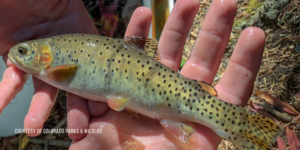
Greenback Cutthroat Trout (Oncorhynchus clarkii stomias)
Endemic to the cold, clear waters of the South Platte and Arkansas River basins in Colorado, the Greenback cutthroat trout holds a special place in the hearts of anglers and conservationists alike. This prized subspecies is recognized for its distinctive features, including an olive-green body, yellowish lower fins, and vibrant red slashes that adorn its throat. Despite once being believed extinct, the rediscovery of remnant populations has ignited a renewed sense of hope and urgency to safeguard and restore this iconic trout.
The Greenback cutthroat trout faced a perilous decline in the past, primarily due to overfishing, habitat degradation, and competition with non-native species. As a result, it was thought to be extinct by the late 1800s. However, small populations of Greenback cutthroat trout were found in remote headwater streams, providing a glimmer of hope for its survival. In response to this discovery, dedicated conservation actions have been initiated to protect and restore the Greenback cutthroat trout populations. Collaborative endeavors involving federal and state agencies, conservation organizations, and local communities have been instrumental in ensuring the conservation and long-term viability of the Greenback cutthroat trout. By preserving its unique genetic lineage and restoring its native habitats, the aim is to secure a future where this iconic trout can thrive once again in the South Platte and Arkansas River basins.

Rio Grande Cutthroat Trout (Oncorhynchus clarkii virginalis)
The Rio Grande cutthroat trout finds its home in the pristine headwaters of the Rio Grande and its tributaries, nestled in the picturesque landscapes of New Mexico and southern Colorado. This subspecies of cutthroat trout showcases a remarkable combination of vibrant colors, with striking orange-red slashes adorning its body of yellowish hue. The Rio Grande cutthroat trout’s appearance serves as a testament to the rugged beauty of its native habitats and the importance of preserving their ecological integrity.
Conservation efforts for the Rio Grande cutthroat trout focus on preserving and expanding its populations. Restoration projects aim to enhance stream habitats, improve water quality, and create conditions conducive to the subspecies’ reproduction and survival. Collaborative partnerships between government agencies, conservation organizations, and local communities play a crucial role in implementing these conservation measures. By protecting the Rio Grande cutthroat trout and its native landscapes, conservationists strive to maintain the delicate balance of the ecosystem and preserve the awe-inspiring beauty of this subspecies for future generations to cherish.
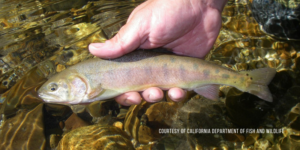
Paiute Cutthroat Trout (Oncorhynchus clarkii seleniris)
The Paiute cutthroat trout, an exquisite subspecies of cutthroat trout, is native to the pristine waters of Silver King Creek in the eastern Sierra Nevada Mountains of California. Recognized for its breathtaking beauty, this trout showcases a dazzling golden body adorned with small black spots that create a mesmerizing pattern. Its vibrant red-orange slashes add a touch of brilliance, making the Paiute cutthroat trout a true jewel of its habitat.
The Paiute cutthroat trout is critically endangered, facing the looming threat of extinction. Factors such as habitat degradation, introduced non-native species, and overfishing have severely impacted its population. Intensive conservation measures have been implemented to prevent the loss of this remarkable subspecies and restore its population to sustainable levels.
Captive breeding programs play a pivotal role in the conservation efforts for the Paiute cutthroat trout. By carefully breeding individuals in controlled environments, conservationists aim to increase their numbers and genetic diversity, ensuring the long-term survival of the subspecies. Additionally, habitat restoration initiatives are underway to enhance the conditions of Silver King Creek and its surroundings, providing the Paiute cutthroat trout with a thriving ecosystem in which to flourish.
The United States is home to a remarkable array cutthroat trout, each possessing unique characteristics and ecological significance. From the coastal cutthroat trout of the Pacific Coast to the elusive Lahontan cutthroat trout of Pyramid Lake in Nevada, and from the iconic Yellowstone cutthroat trout to the endangered Paiute cutthroat trout, these subspecies represent a tapestry of vibrant colors and adaptations. As stewards of our natural heritage, it is our responsibility to safeguard their habitats, promote conservation efforts, and ensure the long-term survival of these magnificent fish. By valuing and protecting the diverse subspecies of cutthroat trout, we contribute to the preservation of our nation’s biodiversity and uphold the interconnected web of life that depends on it.


